How to Use a Tongue Scraper (and Why You Should Make it a Habit)
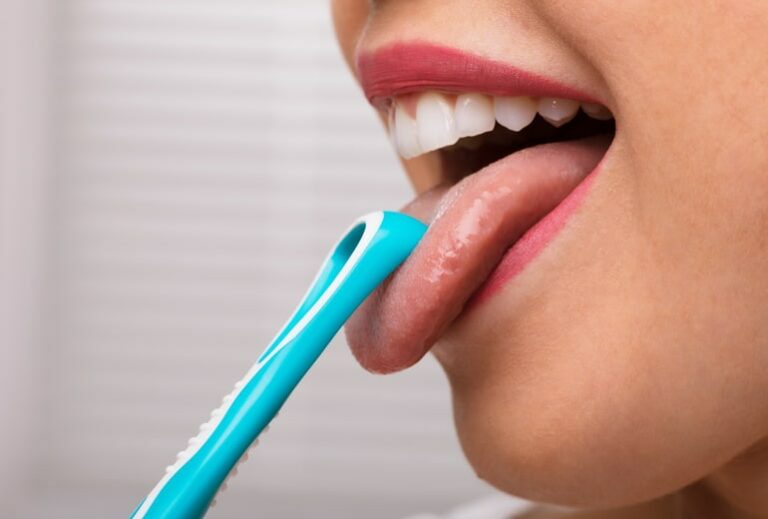
While tongue scraping has seen a surge in popularity over the past decade, this holistic oral care treatment can trace its origins to Ayurveda, an ancient Hindu practice centered around digestive health and balance in the human body.
In this post:
- Health Benefits of Using a Tongue Scraper
- How to Choose a Tongue Scraper
- How to Use a Tongue Scraper Properly
- Tips for Effective, Healthy Tongue Scraping
In modern times, studies1 have shown that daily tongue scraping improves oral health safely and effectively by managing the buildup of plaque and debris and reducing volatile sulphur compounds (VSCs) responsible for bad breath. Tongue scraping also improves the sensitivity of taste buds, and improves the health of soft tissues in the mouth by increasing circulation and blood flow.
Let’s take an in-depth look at the benefits of daily tongue scraping, how to use a tongue scraper, pros and cons of the various tongue scrapers, and tips for effective tongue scraping.
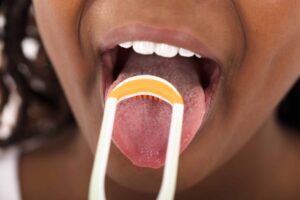
Using a tongue scraper improves the sensitivity of taste buds and overall oral health.
Health Benefits of Using a Tongue Scraper
Tongue scraping has numerous benefits, not least of which is the satisfaction of seeing the gunk that was once in your mouth go down the drain!
1. Improves Your Oral Hygiene
Studies show that tongue scraping has long-term benefits for oral health2. Not only does tongue scraping temporarily remove residue and bacteria from the mouth, but over time, tongue scraping reduces the overall levels of harmful bacteria in the mouth, allowing for a more balanced, healthy oral ecosystem that is more resistant to tooth decay and gum disease.
2. Fosters Healthy Tissue
Tongue scraping also improves blood flow and circulation to the tongue and mouth, vital to healthy tissue growth and cellular growth. This improved blood flow delivers oxygen and nutrients to the tongue and surrounding tissue more effectively, helping the body repair damaged cells, heal micro-injuries like tiny scrapes from eating, and fight possible infections.
3. Improves Your Sense of Taste
Just like it’s difficult to smell properly with a stuffy nose, it’s difficult to taste properly with a coated tongue. Daily tongue scraping, which removes a filmy layer of debris, plaque, and dead skin cells from the surface of the tongue, allows the taste buds to react unencumbered to the taste of food.
Many individuals who adopt a tongue-scraping practice report a heightened taste response to sweet, salty, and spicy food because their taste buds aren’t covered in a layer of gunk. This increased taste sensitivity can lead to improved nutrition5, since there’s no need to “over-flavor” your food with salt and sugar. The ancient Hindu practice of Ayurveda teaches that unblocking the taste buds also improves the brain’s ability to communicate its nutritional needs and reduces unhealthy cravings.

A tongue scraper helps to “cleanse your palate” so you can truly taste what you're eating.
4. Reduces Cravings for Fat, Salt, and Sugar
Along the same lines, tongue scraping can also reduce fat, salt, and sugar cravings!3 Why? Because when you “cleanse your palate” by removing the buildup of debris and residue, you can taste and enjoy the natural, complex flavors of food more easily. Think of it this way: When your taste buds are buried beneath layers of junk, their capacity to interact with the food you eat is pretty low. Tongue scraping allows them to taste the full flavor, complexity, and intensity of food without amplifiers like fat, salt, and sugar.
5. Combats Depression
The improved sense of taste that goes hand in hand with tongue scraping can also lead to heightened feelings of wellness and satisfaction. This should come as no surprise, since studies have clearly linked a diminished sense of smell/taste with depression.3 In the same vein, a delicious meal is one of the quickest ways to a dopamine rush4. And a clean, residue-free tongue is key to fully enjoying that meal!
6. Improves Bad Breath
Bad breath, also known as “halitosis,” is a result of the interplay between bacteria, dead skin cells, food debris, and residue in the mouth. This bacteria produces volatile sulphur compounds, the primary culprit for bad breath. And while brushing and flossing your teeth help significantly, the soft, textured surface of the tongue still holds onto a filmy residue.
Smoking, eating a diet high in processed foods, certain medicines, and sleeping with your mouth open can dramatically increase the amount of residue on the tongue--and the accompanying bad breath and decreased oral health.
Most of the unhealthy residue on the tongue is found at the back of the mouth. A standard toothbrush has a difficult time reaching this area without activating the gag reflex, not to mention that the brushing motion does little more than spread the residue around or send it down the throat.
One significant study found that tongue scrapers reduced volatile sulphur compounds by an incredible 75 percent1, as compared to 45 percent from brushing and flossing alone.
7. Removes Toxic Residue
It’s no coincidence that you notice the most residue on your tongue after a good night’s sleep. Not only has your mouth been resting from eating and drinking, allowing a buildup of plaque, bacteria, and residue, but sleep is the time your body works the hardest to repair and slough off damaged cells, detoxify, and renew itself.
By scraping off the dead cells, excess bacteria, and buildup you find on your tongue in the morning, you’re helping your body remove (rather than reingest) this layer of dead cells and toxins released during sleep that can be a breeding ground for unhealthy bacteria (including the microbes notorious for causing gum disease5) and bad breath.
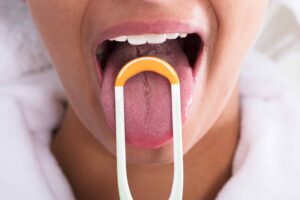
Small tongue scrapers that can be held with one hand are more manageable.
How to Choose a Tongue Scraper
When shopping around for a tongue scraper, you’ll notice that some scrapers look like thin, shaped wire (made to be used with two hands), while other scrapers look more like small handheld razors (made to be used with one hand). Like razors, all tongue scrapers have one or more scraping blades to remove residue (don’t worry, they’re not sharp!).
Small tongue scrapers that can be held with one hand may be more manageable for children and easier to pinpoint and scrape specific places on the tongue.
Larger, wire-type tongue scrapers can be beneficial for covering more ground more quickly and come in two basic shapes: Y shaped and U shaped. There are specific pros and cons of each shape, which you should take into consideration when purchasing a tongue scraper:
Y-Shaped Tongue Scrapers: Pros and Cons
PROS
- Better for people with smaller tongues (including children), since the Y shape is most adaptable to small corners
- Better for people with a high gag reflex, since the Y shape has a slimmer profile
CONS
- Tongue scraping takes slightly longer, due to its smaller surface area
U-Shaped Tongue Scrapers: Pros and Cons
PROS
- Better for people with larger tongues, since the u-shape covers more ground more quickly
CONS
- Can cause a more pronounced gag reflex in sensitive individuals because of its wider profile
Consider Number of Blades, Materials, and Cost of Tongue Cleaners
When choosing a tongue scraper, you’ll also want to consider the number of blades and type of material.
How many blades is best in a tongue scraper?
Tongue scrapers typically have between one and five blades. And while more blades will be more efficient in scraping, they can be hard on a sensitive tongue and can more easily inflict accidental injury.
What are tongue scrapers made of?
Tongue scrapers can be made of metal (like steel and copper) or plastic. Stainless steel and copper tongue scrapers are more durable and less prone to losing their shape and cracking over time; however, they are also more expensive, and some people are sensitive to the taste of metal.
How much do tongue scrapers cost?
Plastic tongue scrapers may cost as little as $5, while stainless steel or copper tongue scrapers typically run between $10-$30.
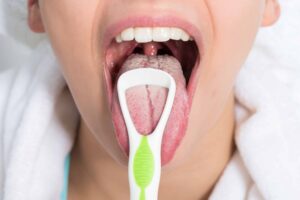
When you first begin a tongue-scraping routine, be gentle! Over time, your tolerance for the scraping motion will build.
How to Use a Tongue Scraper Properly
- Open your mouth as wide as you can, without causing discomfort.
- Stick your tongue out as far as possible, keeping your tongue and mouth relaxed (don’t point your tongue).
- Position your tongue scraper as far into your mouth as you comfortably can, without eliciting a gag reflex or discomfort.
- Draw the tongue scraper from back to front, across the surface of your tongue in a smooth motion with gentle pressure. The surface of the tongue scraper will remove plaque, residue, and other particles that contribute to halitosis and gum disease.
- Rinse your tongue scraper in warm water to remove plaque and residue, then repeat the scraping process 5-8 times. When you are finished scraping, clean your tongue scraper with warm, soapy water and allow the scraper to air dry.
Tips for Effective, Healthy Tongue Scraping
- Always scrape back to front, never front to back! Scraping backward may spread plaque and residue around, or push it further into the mouth. Remember, the goal is to remove residue from the mouth. Scrape forward in one smooth, firm motion, and rinse the scraper between strokes.
- Build your tolerance gradually. When you first begin a tongue-scraping routine, be gentle! Over time, your tolerance for the scraping motion will build, and you will learn how much pressure is too much, or not enough.
- Don’t over-scrape. Scraping once each day, for 5-8 strokes, is ideal. The skin in your mouth is sensitive, and over-scraping can result in micro-injuries or damage to your taste buds and tissues.
- Store your scraper in a clean, dry place. Rinse your tongue scraper between each scrape, then clean your tongue scraper with soap and water after each use. Instead of storing your scraper in a drawer (which can lead to slower drying and the potential for bacteria on the wet surface), store it upright in a toothbrush stand.
- Regularly sanitize your scraper. Once a week, place your tongue scraper in boiling water to sanitize it, and avoid any colonization of bacteria.
Tongue scraping is a satisfying, easy, and beneficial part of a daily oral hygiene routine. When used alongside brushing and flossing, tongue scraping can improve the health of your mouth and the freshness of your breath.
Once you add tongue scraping to your oral care routine, you’ll wonder how you ever went without it!
Read next: A Dentist on Natural Teeth Whitening (and Which Procedure to Skip)

Disclosure: This post may contain affiliate links that help support the GSG mission without costing you extra. I recommend only companies and products that I use myself.
Sources
- Pedrazzi V., Sato S, de Mattos Mda G, Lara EH, Panzeri H. Tongue-cleaning methods: a comparative clinical trial employing a toothbrush and a tongue scraper. J Periodontol. 2004 Jul; 75(7): 1009-12.
- Miki Matsui, Naoyuki Chosa, Yu Shimoyama, Kentaro Minami, Shigenobu Kimura and Mitsuo Kishi. Effects of tongue cleaning on bacterial flora in tongue coating and dental plaque: a crossover study. BMC Oral Health. 2014, 14:4.
- Christianson, Alan. The Metabolism Reset Diet: Repair Your Liver, Stop Storing Fat, and Lose Weight Naturally. Harmony, January 29, 2019.
- Joo YH, Hwang SH, Han KD, Seo JH, Kang JM. Relationship between olfactory dysfunction and suicidal ideation: The Korea National Health and Nutrition Examination Survey. Am J Rhinol Allergy. 2015 Jul-Aug; 29(4): 268-72.
- Fetissov SO. [Hunger and satiety factors in the regulation of pleasure associated with feeding behavior]. Biol Aujourdhui. 2016; 210(4): 259-268.
- Carey O’Rielly, DDS. 5 Microbes That Cause Gum Disease. https://myholisticdentist.com/2017/09/24/5-microbes-that-cause-gum-disease/. Sep 24, 2017.
Posted in: Dental Health



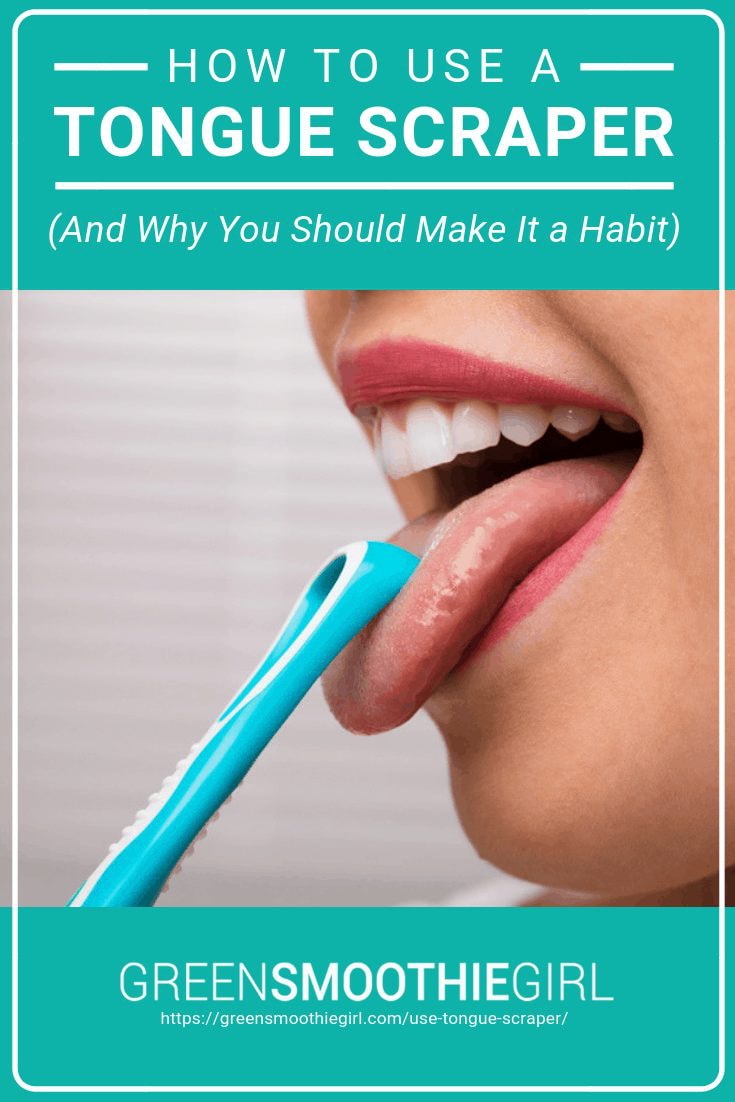












No comments found, but you can be our first!